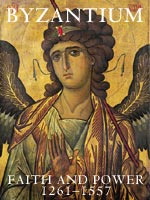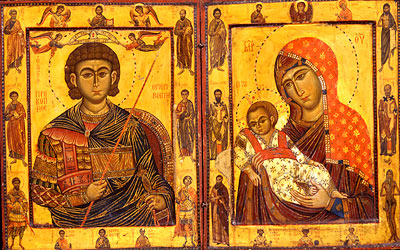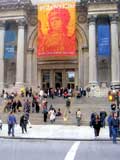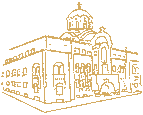| Information
Service of
the Serbian Orthodox Church
April 19, 2004
The
Glory of Byzantium

THE
NEW YORK TIMES
http://www.nytimes.com/2004/03/22/arts/design/22BYZA.html
ARTS
March
22, 2004
Glittering
Trove Built on Trust Across Borders
By CAROL VOGEL
As Helen C.
Evans was putting together "The Glory of Byzantium, A.D.
843-1261," the sumptuous exhibition that opened at the Metropolitan
Museum of Art in 1997 and attracted a staggering 460,854 visitors,
she
was already planning a sequel. Ms. Evans, the museum's curator
of early
Christian and Byzantine art, knew there was more to be told.
"The
last big centuries of Byzantium have never been explored in an
exhibition," Ms. Evans said. "And they're by far the
most important
because they represent the empire at its peak."
So
for seven years Ms. Evans and Mahrukh Tarapor, the museum's associate
director for exhibitions, traveled to places few would dare, organizing
"Byzantium: Faith and Power (1261-1557)," a feat of
international diplomacy that opens at the Met tomorrow and runs
through July 4.
Byzantium,
the name given to both the state and the culture of the
Eastern Roman Empire in the Middle Ages, saw a great artistic
outpouring. "Byzantium Faith and Power" begins in 1261,
when the capital
Constantinople (now Istanbul) was restored to imperial rule after
its
sacking by the Crusaders. It concludes in 1557, when the empire
that had
fallen to the Ottoman Turks in 1453 was renamed Byzantium, the
name by
which it is still known.
The art and
objects of that era, produced primarily for the Orthodox
Church - sacred painted icons, lavishly embroidered silk textiles,
richly gilded metalwork, illuminated manuscripts, delicate
micromosaics - illustrate the artistic treasures that have come
to
define Byzantium.
The show is
the last of a grand trilogy. In 1977 Ms. Evans organized
"The Age of Spirituality," which dealt with Christian
art between the
third and eighth centuries A.D., followed by "The Glory of
Byzantium" in
1997.
Less than
10 percent of the art and objects presented in "Byzantium:
Faith and Power" had ever left their home countries, the
curators said.
While negotiating these loans Ms. Evans and Ms. Tarapor visited
35
countries. They spent days waiting to be summoned by archbishops
of the
Orthodox Church, went mountain climbing with monks at midnight
and
pressed their case with political figures.
Their wish
list included 14th- and 15th-century icons and richly
illustrated manuscripts, miniature mosaics created in court ateliers
of
Constantinople and elaborately embroidered religious vestments
of silk,
gold and gems, each a priceless example of cultural heritage.
Despite a
political landscape altered drastically by the events of Sept.
11, 2001, the curators were able to gather some 350 examples of
Byzantine art from about 30 nations, including Greece, Bulgaria,
Egypt,
France, Italy, Romania, Russia, Turkey, Serbia and Montenegro
and
Macedonia.
Ms. Tarapor
said that she and Ms. Evans were "affected by world events
even before September 11th" and noted that with "any
political event,
whether small or large, we would feel the tremors."
"We were
dealing with a living faith and a glorious culture," Ms.
Tarapor added. "But at the same time the cultures we were
trying to
display were in ruins."
Because of
the war in Kosovo, she and Ms. Evans had to postpone
traveling to Serbia. Eventually Slobodan Curcic, a professor in
the
department of art and archaeology at Princeton University, took
them to
Belgrade, the Serbian capital. "I'd never seen the effects
of a real
bombing," Ms. Tarapor said. "It was a shock and very
sobering."
One place
that resisted their entreaties was Mount Athos, an ancient
community of 20 monasteries on a rocky peninsula in northern Greece.
Since women were not allowed there, "we would go to the border
and a
priest would come down to have lunch with us," Ms. Tarapor
said. "We'd
talk." They had no luck because the monastery has been hesitant
to lend
since the start of the war in Iraq. Still, they managed to get
important
loans of art and objects that originally came from Mount Athos
but were
now in other collections.
"It was
all about trust," Ms. Tarapor said of getting monasteries
to
part with portions of their collections. And sometimes about giving
them
a little help. The Holy Monastery of St. Catherine, on the Sinai
Peninsula in Egypt, had lent 10 works for the 1997 show. This
time it
has contributed 43 objects.
In exchange
the museum helped design a new sacristy area, which is being
paid for by some of the exhibition's donors. Now the monastery,
which
draws many tourists, will be able to preserve its treasures and
display
them with greater security. The museum also published a book of
photographic essays, with royalties going to St. Catherine's.
Museum officials
would not say exactly how much this exhibition cost.
But people inside the museum said it was close to $4 million,
nearly $1
million more than "The Glory of Byzantium," making it
one of the most
expensive shows in the Met's history. It has financing from the
Arts and
Artifacts Indemnity program, as well as support from the National
Endowment for the Arts. The show also has Greek and Cypriot sponsors:
Alpha Bank, the J. F. Costopoulos Foundation, the A. G. Leventis
Foundation and the Stavros S. Niarchos Foundation.
To ensure
the safe travel of many treasures in the show, conservators
from the Met designed climate-controlled cases in New York and
then
traveled to places like the Sinai Desert with the proper crates
and
packing materials.
Installing
the show was a bit like running the United Nations. For days
before the opening the first gallery became a staging area for
inspecting objects as they were being unpacked. Throughout the
galleries
languages from around the globe could be heard.
One object
of which Ms. Evans is particularly proud is the "Holy Face
of
Laon," a 13th-century cedar panel with the face of Jesus
on it from the
Laon Cathedral in Northern France. The state turned down a request
from
the Vatican when it tried to borrow it four years ago. "We
worked with
priests and with the French government," Ms. Evans said.
"Eighteen
people attended the packing, including the local bishop and every
government and church official."
Icons borrowed
from the Holy Monastery of St. Catherine are shown in a
gallery designed to evoke the nave of the church there, built
in the
sixth century by the Emperor Justinian. Forty-three icons are
hung in
groups in the gallery as they are hung on rails in the original
church.
A nearby gallery contains a stunning collection of micromosaics,
the
tiniest mosaics set in beeswax. "They are the greatest art
form of the
late Byzantine," Ms. Evans said, noting that few survive.
The exhibition
is rich in gold-ground painted icons. In the gallery of works
from St.
Catherine is a large diptych that shows St. Prokopios and the
Virgin
Kykkotissa. Above her is the image of the Virgin in the burning
bush.
There is also a monumental pair of full-length figures of two
saints,
Gregory the Theologian and John Chrysostom, from around 1408.
The icons
were borrowed from the State Tretiakov Gallery in Moscow.
The show also
has rooms of richly embroidered textiles and objects, like
a giant copper chandelier, or choros, that frequently hung in
late-Byzantine churches. Vitrines contain elaborate, illuminated
manuscripts and fresco decorations.
One
would think the topic had now been well explored, but Ms. Evans
is
already busy planning her next big exhibition. "Hopefully
it will be
about the myth of Byzantium," she said. "I'd like to
call it `Sailing to
Byzantium,' after the Yeats poem. We've spent the past two exhibitions
making the empire real. Now I would like to explore the romantic
vision
and why we think of it as a fairy tale."

Metropolitan
Museum Byzantium: Faith and Power
Byzantium:
Faith and Power (1261–1557)
March 23, 2004–July 4, 2004
Special Exhibition Galleries, The Tisch Galleries, 2nd floor
http://www.metmuseum.org/special/se_event.asp?OccurrenceId={9A19B99B-ECDE-4EF0-A021-01168C413561}&HomePageLink=special_c2b
 The
third exhibition in a chronological series devoted to the art
and influence of Byzantine civilization, this major international
loan exhibition demonstrates the artistic and cultural significance
of the last centuries of the state that called itself “the Empire
of the Romans.” The exhibition begins in 1261, when the capital
Constantinople was restored to imperial rule, and concludes in
1557, when the empire that had fallen to the Ottoman Turks in
1453 was renamed Byzantium—the name by which it is still known
today. The importance of the era is primarily demonstrated through
the arts created for the Orthodox church and for the churches
of other East Christian states that aspired to be the heirs to
the empire’s power. The impact of its culture on the Islamic world
and the Latin-speaking West is also explored—especially the influence
of the Christian East on the development of the Renaissance. The
third exhibition in a chronological series devoted to the art
and influence of Byzantine civilization, this major international
loan exhibition demonstrates the artistic and cultural significance
of the last centuries of the state that called itself “the Empire
of the Romans.” The exhibition begins in 1261, when the capital
Constantinople was restored to imperial rule, and concludes in
1557, when the empire that had fallen to the Ottoman Turks in
1453 was renamed Byzantium—the name by which it is still known
today. The importance of the era is primarily demonstrated through
the arts created for the Orthodox church and for the churches
of other East Christian states that aspired to be the heirs to
the empire’s power. The impact of its culture on the Islamic world
and the Latin-speaking West is also explored—especially the influence
of the Christian East on the development of the Renaissance.
Accompanied by a catalogue.
In connection with the exhibition, a major symposium on "Byzantium:
Faith and Power" will be held at the Metropolitan Museum
from Friday, April 16, to Sunday, April 18. The event will include
scholarly presentations and a concluding performance. For more
information, call 212-570-3710 or email lectures@metmuseum.org.
The
exhibition is made possible by Alpha Bank.
Sponsorship is also provided by the J. F. Costopoulos Foundation,
the A. G. Leventis Foundation and the Stavros S. Niarchos Foundation.
Additional support has been provided by the National Endowment
for the Arts.
An indemnity has been granted by the Federal Council on the Arts
and the Humanities.

The
Economist Newspaper and The Economist Group
http://www.economist.com/books/displayStory.cfm?story_id=2535873
The
art of Byzantium
Glories
of gold
Mar
25th 2004
From The Economist print edition
Byzantium's
icon painters were the Mel Gibsons of their day—and more
 NEW
YORKERS are assaulted by thousands of images every day. In recent
days, scenes from the death, burial and resurrection of Jesus
Christ—all of them images designed to make people think harder
about the relationship between spiritual authority and earthly
power—have had an unaccustomed impact. NEW
YORKERS are assaulted by thousands of images every day. In recent
days, scenes from the death, burial and resurrection of Jesus
Christ—all of them images designed to make people think harder
about the relationship between spiritual authority and earthly
power—have had an unaccustomed impact.
Thus
far, at least, we might be speaking of Mel Gibson's blockbuster
film, “The Passion of The Christ”—or of another, rather more rarefied
event that will nonetheless make a deep impression on American
consumers of high culture: the opening at the Metropolitan Museum
of Art of a wonderfully rich selection of the artistic and spiritual
achievements of late Christian Byzantium, and its imitators in
the Slavic world.
Inevitably, comparisons will be made. For better or worse, Mr
Gibson's film is probably the most ambitious attempt to recreate
on film the 2,000-year-old story in whose light more than a billion
people alive today believe themselves to be living. At least in
theory, every drop of historical knowledge and technology available
to a modern cinematographer has been deployed to make the film
as “realistic” as possible, in terms of landscape, architecture
and even language.
The
icons, manuscripts, embroidered vestments and other religious
objects on show at the Met do not set out to achieve that sort
of verisimilitude. But they are among the supreme achievements
of another era's effort to describe the same narrative through
an entirely different medium, that of formal sacred art oriconography.
Is
there really such a difference? Mr Gibson's film company is called
Icon Film Distribution, and its logo is one of Russia's most beloved
sacred images, the tender, mournful depiction of Mary known as
the Vladimir Mother of God. But as visitors to the Met—regardless
of their religious affiliation—will almost certainly notice, the
Byzantine iconographers' Christ is very far from that of Mr Gibson,
in spirit as well as detail. The film's most powerful images are—to
put it mildly—somewhat one-dimensional: they show a man enduring
torture and abasement at the limits of human endurance, for a
reason which a person unfamiliar with the story would find hard
to discern. Presumably, the untutored viewer might conclude that
the hero was a gifted preacher who had somehow incurred the wrath
of his rulers; but it would still be hard to work out what the
point of the story was.
The
Byzantine Christ, by contrast, never ceases to be many different
things at once: divine and human, humiliated and victorious, wounded
and healing. Even at the darkest moments of the Passion story,
the dawn is already present. Even when Christ is at his most humble
and abased, he never ceases to be the Word of God made flesh.
The
conventions of icon-painting, on which individual artists could
make only slight (but often brilliant) variations, are designed
with these very paradoxes in mind. Grief and pain are expressed
with restraint, not self-indulgence; joy and sorrow, abasement
and victory, the transient and the eternal are endlessly combined.
One
of the most astonishing images on show at the Met is a virtually
monochrome Christ, borrowed from Russia but originating from somewhere
in the Balkans, in which the eyes are closed and the body hunched
in a pose of Munch-like intensity: it is full of cosmic, rather
than individual, pain and there is not a hint of the narcissism
which Mr Gibson's Christ often seems to display. The title, bestowed
without irony, is the “King of Glory”.
As
their makers conceived them, these icons are not decorations,
photographs or historical records: they are windows on to heaven
through which the believer can enter a higher reality. Even as
nails pierce his hands, the Christ of Byzantine icons is still
God incarnate, surrounded by a golden halo which glows even brighter
as the conquest of death itself is accomplished. Blood flows from
his side in a stylised stream, bringing life and healing to the
stony hill below.
In
iconography, moreover, the Cross itself, with its T-shaped elongated
arms, is not so much a literal depiction of the Roman empire's
preferred instrument of torture: it is a benign kind of tree,
with echoes of the Tree of Life in the Garden of Eden, whose branches
reach out in a gesture of protection and healing to the human
race.
Precisely
the same sort of paradox is elaborated, over and over again, in
the liturgical poetry of the eastern Church: this is not just
a man suffering, but the Creator himself entering the darkest
moments of the human experience and hence redeeming them. When
Mary Magdalene speaks to Christ, it is not simply a friend she
addresses but her God: “Accept the fountain of my tears, O Thou
who drawest down from the clouds the waters of the sea.” When
Christ is laid in the tomb, he is attended by adoring angels;
they at least know that he has never ceased to be God.
More
than 350 objects—icons, manuscripts, vestments and other gorgeously
embroidered fabrics—have been gathered together, including 40
from St Catherine's Monastery in Sinai and several from Kosovo
where more than a dozen churches were destroyed last week. This,
the third and last in a series of shows that the Met has devoted
to the empire of Byzantium, tries to recreate the so-called Byzantine
commonwealth as it existed before and after the Ottoman Turkish
conquest of Constantinople in 1453. Was it the twilight of Christian
Constantinople, then? No, insists Helen Evans, who curated the
exhibition. What she is trying to show is that even as Constantinople's
territory shrank to a small patch of land outside the city, its
artistic and spiritual power continue to pulsate like a beacon
throughout the eastern half of Christendom.
The
Serbs, Bulgarians and above all the Russians had no wish to live
under the political sway of a Greek-speaking empire; but they
acknowledged Constantinople's authority in matters of art and
theology by reproducing and developing the models which had first
been made on the shores of the Bosphorus.
After
the Ottoman Turkish triumph of 1453, the Greek patriarchate's
authority over the new empire's Christian subjects was left intact
and in some ways broadened—but its claim to be the main spiritual
centre of Orthodoxy (and also to be the heir of at least one part
of the Roman empire) was challenged by Moscow.
As
the exhibition shows, the battle within eastern Christendom for
the mantle of spiritual and secular power was at times a ruthless
affair; in these wars the humility of God-incarnate hanging on
the Cross can be very hard to discern. But even as the would-be
rulers of earthly kingdoms did battle, the artists they commissioned—often
for reasons that were closely connected with earthly power struggles—had
a deep sense of the spiritual struggle at the heart of their faith;
and they portrayed it in a more subtle way than cinema has so
far managed to do.

An
article by Ma¼a Herman-Sekulic was published in the magazine "Gloria"
on April 14, 2004 regarding an exceptionally successful exhibition
in New York City
Spring
in New York City
BYZANTIUM
ON FIFTH AVENUE
 "At
the end of March the third exhibition in a series was opened in
the Metropolitan Museum in New York City dedicated to Byzantine
art called "Byzantium: Faith and Power (1261-1557)".
Since then the museum building on Fifth Avenue has flown the flag
of Byzantium and the exhibition has marked the coming of spring
to New York City. For the first time more than 350 masterpieces
have been collected from 30 countries of Europe and Asia in one
place. Much space has been given to works from our region: "At
the end of March the third exhibition in a series was opened in
the Metropolitan Museum in New York City dedicated to Byzantine
art called "Byzantium: Faith and Power (1261-1557)".
Since then the museum building on Fifth Avenue has flown the flag
of Byzantium and the exhibition has marked the coming of spring
to New York City. For the first time more than 350 masterpieces
have been collected from 30 countries of Europe and Asia in one
place. Much space has been given to works from our region:  fragments
of frescoes and items such as silver coins from the time of the
Serbian Emperors Dusan and Uros, the sarcophagus of King Stefan
Uros III from Decani Monastery, the sculpture of the Mother of
God with Child from Sokolica Monastery in Kosovo, a gorgeous stone
rosetta, the ring of the Empress Theodora, the chalice of Stefan
Uros IV, the Emperor Dusan from the National Museum and icons
from Ochrid. fragments
of frescoes and items such as silver coins from the time of the
Serbian Emperors Dusan and Uros, the sarcophagus of King Stefan
Uros III from Decani Monastery, the sculpture of the Mother of
God with Child from Sokolica Monastery in Kosovo, a gorgeous stone
rosetta, the ring of the Empress Theodora, the chalice of Stefan
Uros IV, the Emperor Dusan from the National Museum and icons
from Ochrid.
In
the words of the director of the Metropolitan Museum, the exhibition
has been seven years in the making and its realization would have
been impossible without close cooperation with institutions such
as the Museum of the Patriarchate and the National Museum in Belgrade.
Many of the artifacts left the monasteries and countries where
they originate for the first time. In honor of this exhibition
exceptionally beautiful copies of Byzantine jewelry were also
prepared in India from emeralds, pearls and rubies in 24-carat
gold.
To
this we must add: Spring has come to New York City with the breath
of Byzantium. In our part of the world, where many of the exponents
on display originate, spring began with the smoke and flames of
torched holy shrines and the houses of the descendants of those
who created this beauty.


Copyright © 1999-2004 by
The Information Service of
the Serbian Orthodox Church
11000 Belgrade
Kralja Petra I no.5
+381 11 3282 596
e-mail
|

